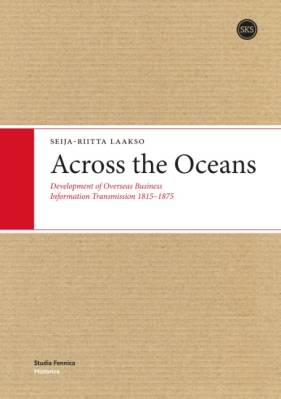Across the Oceans — Development of Overseas Business Inforrmation Transmission 1815-1875
Laakso, Seija-RiittaProduktinformation
| Titel: | Across the Oceans — Development of Overseas Business Inforrmation Transmission 1815-1875 | ||
| Författare: | Laakso, Seija-Riitta (Författare) | ||
| Artikelnummer: | 9789517469043 | ||
| Form: | Mjukband | ||
| Tillgänglighet: | Leveranstid 7-14 dagar | ||
| Pris: | 32,00 € (28,07 € moms 0 %) | ||
|
|||
| Förlagets identifieringsnummer: | 1366312 |
| Förlag: | Suomalaisen Kirjallisuuden Seura |
| Serie: | Studia Fennica Historica 13 |
| Upplaga: | 2007 |
| Utgivningsår: | 2007 |
| Språk: | engelska |
| Antal sidor: | 459 |
| Produktgrupp: | Historia Studia Fennica Historica Books in English |
| Bibliotekssignum: | 91.7 Nya tiden 1500-1788 |
| ALLFO - Allmän finländsk ontologi: | tiedonkulku, viestintä, laivaliikenne, meriliikenne, postiliikenne, posti, historia |
| Ämnesord: | Ship Traffic, mail, Postal Traffic, communication, Flow of information |
In the early 19th century, the only way to transmit information was to send letters across the oceans by sailing ships or across land by horse and coach. Growing world trade created a need and technological development introduced options to improve general information transmission. Starting in the 1830s, a network of steamships, railways, canals and telegraphs was gradually built to connect different parts of the world.
The book explains how the rate of information circulation increased many times over as mail systems were developed. Nevertheless, regional differences were huge. While improvements on the most significant trade routes between Europe, the Americas and East India were considered crucial, distant places such as California or Australia had to wait for gold fever to become important enough for regular communications. The growth of passenger services, especially for emigrants, was a major factor increasing the number of mail sailings.
The study covers the period from the Napoleonic wars to the foundation of the Universal Postal Union (UPU) and includes the development of overseas business information transmission from the days of sailing ships to steamers and the telegraph.
The book explains how the rate of information circulation increased many times over as mail systems were developed. Nevertheless, regional differences were huge. While improvements on the most significant trade routes between Europe, the Americas and East India were considered crucial, distant places such as California or Australia had to wait for gold fever to become important enough for regular communications. The growth of passenger services, especially for emigrants, was a major factor increasing the number of mail sailings.
The study covers the period from the Napoleonic wars to the foundation of the Universal Postal Union (UPU) and includes the development of overseas business information transmission from the days of sailing ships to steamers and the telegraph.





